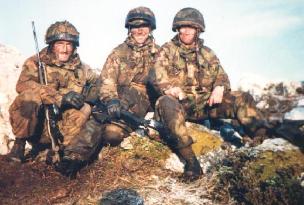I find there are two kinds of weathering of clothes...
Immediate- you roll in the mud, you get mud on you, tromping along a dry dirt road, you get covered in dust. These are on the surface and the dirt on the fig has to match the colours of the groundwork.
Long term- a man on campaign will gather dirt on dirt on sweat on dirt. As well, sun and rain will fade the colour out of a uniform.
For immediate weathering, transfering ground colours up the figure, covering boots, lower pants, coat hems with dust effects touching the tops of shoulders and hats etc will work. Basically extending groundwork techiques up onto the figure in appropriate areas.
Ground in dirt can be achieved by mixing ground colours into the uniform colour and touching areas that would be affected ie knees, elbows, backside, thigh fronts etc... this effectively puts the dirt colour "into" the fabric. Fading can be shown by "bleaching" your base colour and applying it to the top surfaces that would be constantly exposed to the elements... tops of shoulders, upper back, top of cloth hats etc. Keep in mind, the areas under belts and straps wouldn't be bleached. Sweat stains are obvious, darkening the areas under arms down the front and back of tunics, around collars and most importantly, extending out from under belts, straps and equipment.
To sum up, Immediate effects are on the surface, Long Term effects become part of the material.
Hope these ideas help
Colin






